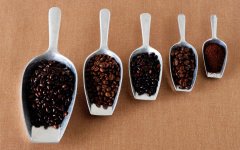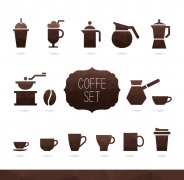The principle and types of coffee roaster Italian blending of direct-fire, semi-hot and hot-air roaster
1. Direct fire type
The earliest baking tools used by human beings are all direct fire, that is, the drum is heated by fire, and then heat transfer to the raw beans in the cylinder. Although, the motor keeps turning the drum and stirring the coffee beans in the cylinder, in an attempt to make each coffee bean touch the hot iron wall evenly, so as to achieve the goal of balanced baking. However, this baking method still has many disadvantages: the heat conduction speed of iron is not fast, so it must take more time to complete baking; on the outside of the burning drum, the hot gas dissipates in the air, which is a pity that it cannot be well utilized; when the raw bean touches the inner wall of the drum for too long, it is easy to be scorched, resulting in bitterness and scorching taste. When baking, there are a lot of crumbs burst out, left in the tube is easy to adhere to the surface of coffee beans, will make the flavor become chaotic.
2. Semi-hot air direct fire type
Between 1870 and 1920, the German Fan Guban improved and manufactured the barrel roaster. In his baking theory, he refers to coffee beans that bring hot air into roasting. In 1907, the German-made Perfekt roaster began to introduce this concept, using gas heating, there is an air pump, half of the hot gas into the drum, half to the outer barbecue drum. Up to now, roller baking in Germany is still widely used, and the country's Probat drum roaster is famous all over the world.
The general roaster uses gas or electricity as the heat source. In 1987, Derek Company of Idaho took the lead in using the infrared heat source activated by gas, which made the temperature control more accurate and well received, and became the first brand in North America.
Today's drum roasters are almost all semi-hot air direct fire type, on the one hand directly heat the drum with the fire source, on the other hand bring the hot air into the drum. The hot air blown into the drum can increase the heating speed and blow away the debris, thus producing balanced and clean coffee beans.
3. Hot air type
In the 20th century, some people thought of using hot air to bake coffee beans, so that without iron barrier, the heat source can be passed more directly to raw beans and improve baking efficiency. In 1934, the Thermonro roaster (jabez burns thermalo) made by the Bourne Company in the United States, that is, a large type of hot air machine, is still used by some large baking plants in the United States.
4. Air bed roaster
The hot air roaster still adopts the drum design to achieve the purpose of balanced baking by rolling and turning the raw beans. However, some people think of using hot air to move raw beans and let them float up and down, breaking the concept of rollers. In 1976, the American Michael Schweitz designed the air bed roaster. In an airtight container, he let the hot air blow from the bottom up, causing the raw beans to float up and down in the container, and it was not until the baking was finished that he poured out the cooling tray outside the container to cool. In Australia, the well-known coffee expert Iomberstein has a similar design and manufacture.
In the process of baking, the moisture in the beans is evaporated less and less, and the mass becomes lighter and lighter. If you use this kind of roaster, the heavy ones will fall quickly and accept the baking of hot air again, so that even coffee beans can be baked up and down repeatedly. However, the lack of metal drum burning, some people will feel that there is a lack of flavor.

Important Notice :
前街咖啡 FrontStreet Coffee has moved to new addredd:
FrontStreet Coffee Address: 315,Donghua East Road,GuangZhou
Tel:020 38364473
- Prev

Deep-roasted coffee beans in the deep baking market coffee merchants choose deep-roasted coffee beans.
1. Deep roasting will make guests who don't know much about coffee feel very coffee-flavored; 2, lower requirements for raw coffee beans, and even do not have to go to the selection of several carefully selected coffee beans to match. The flavor of coffee produced by deep roasting of any kinds of coffee beans is similar, because deep roasting will burn off most of the flavor of coffee beans; 3. Low requirements for coffee machine operators
- Next

The craze of roasting coffee beans in a small amount of household roaster coffee beans Italian blending of coffee beans
Household roaster in recent years the rise of a small amount of coffee roasting craze, there are many household roasters on the market, roasting their own coffee beans has become a very simple thing. At present, household roasters can be divided into three types: self-ignition type, hot air type and drum type. Although these are not very sophisticated professional models, as long as they are handled properly, the roasted coffee beans are still mellow.
Related
- Beginners will see the "Coffee pull flower" guide!
- What is the difference between ice blog purified milk and ordinary milk coffee?
- Why is the Philippines the largest producer of crops in Liberia?
- For coffee extraction, should the fine powder be retained?
- How does extracted espresso fill pressed powder? How much strength does it take to press the powder?
- How to make jasmine cold extract coffee? Is the jasmine + latte good?
- Will this little toy really make the coffee taste better? How does Lily Drip affect coffee extraction?
- Will the action of slapping the filter cup also affect coffee extraction?
- What's the difference between powder-to-water ratio and powder-to-liquid ratio?
- What is the Ethiopian local species? What does it have to do with Heirloom native species?

